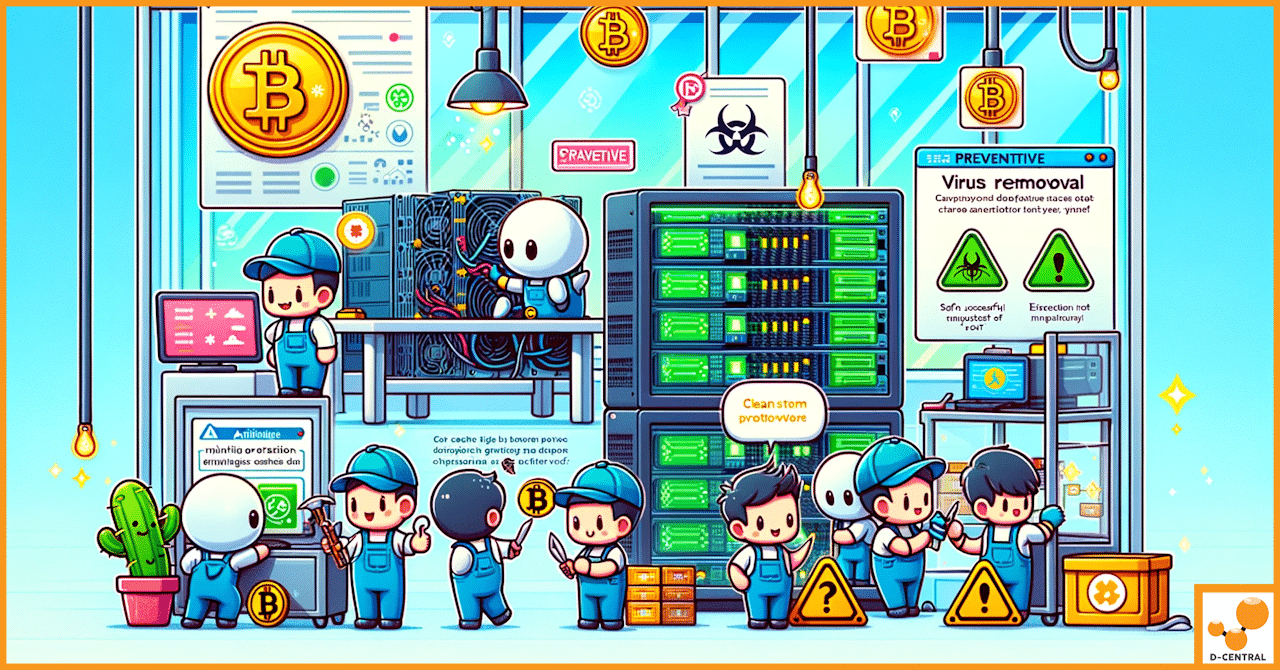
Tapping into Bitcoin Mining’s Potential for Climate Solutions: An Innovative Approach
Navigating crucial environmental considerations can be perceived as a complex task, particularly within sectors reputed for considerable energy consumption, such
4479 Desserte Nord Autoroute 440, Laval, QC H7P 6E2

In the rapidly evolving world of cryptocurrency mining, Application-Specific Integrated Circuit (ASIC) miners have emerged as the backbone of the industry. These specialized devices are engineered to perform the singular task of mining cryptocurrencies like Bitcoin, offering unparalleled efficiency and speed compared to general-purpose hardware. The advent of ASIC miners has significantly intensified the mining competition, making them indispensable for anyone serious about cryptocurrency mining.
However, the sophistication of ASIC miners does not render them immune to the digital ailments that plague the realm of technology. One of the most pressing concerns facing ASIC device operators, particularly those wielding the powerful Antminers, is the threat of virus attacks. These malicious software programs can infiltrate mining operations, hijacking the hardware’s computational power or even rendering the devices inoperable. The consequences of such attacks extend beyond mere performance degradation, posing serious risks to the profitability and viability of mining ventures.
Recognizing the critical role of ASIC miners in the cryptocurrency ecosystem underscores the importance of diligent maintenance and security measures. Ensuring the health and security of these devices is not just about safeguarding an investment; it’s about preserving the integrity of the mining operation and, by extension, the broader network. Effective virus removal and preventive care are paramount to maintaining optimal performance and longevity of ASIC miners. As the landscape of digital threats continues to evolve, so too must the strategies employed by miners to protect their valuable assets. This guide aims to equip ASIC miner operators with essential tips and knowledge for safe and successful virus removal, ensuring their mining endeavors remain both profitable and secure.
Application-Specific Integrated Circuit (ASIC) miners are specialized hardware designed exclusively for cryptocurrency mining. Unlike general-purpose computers or graphics processing units (GPUs) that can perform a wide range of tasks, ASIC miners are engineered to execute specific cryptographic algorithms used in the mining process of particular cryptocurrencies, such as Bitcoin’s SHA-256 algorithm. This specialization allows ASIC miners to achieve unparalleled efficiency and speed, significantly outperforming other types of mining hardware in terms of hash rate and energy consumption. As a result, ASIC miners have become the gold standard in the competitive arena of cryptocurrency mining, playing a pivotal role in securing blockchain networks and validating transactions.
Despite their advanced design and capabilities, ASIC miners are not immune to digital threats. One of the primary vulnerabilities of these devices stems from their constant connectivity to the internet and mining networks, exposing them to potential virus attacks and malware infections. Additionally, the firmware and software that control ASIC miners can contain security flaws or backdoors that malicious actors can exploit. Unauthorized firmware modifications, often sought by miners looking to enhance performance (e.g., overclocking), can further exacerbate these vulnerabilities by introducing unstable or insecure code. Furthermore, the centralized nature of some mining operations, where numerous ASIC miners are connected to a single network, can amplify the risk of widespread infections, turning a single compromised device into a gateway for attacking an entire fleet.
The infiltration of viruses into ASIC miners can have devastating effects on mining operations. At the most basic level, a virus can siphon off computational power, redirecting it to mine cryptocurrency for the attacker’s benefit. This theft not only diminishes the profitability of the mining operation but also increases operational costs due to wasted energy consumption. More malicious viruses can cause significant damage by altering device settings, corrupting firmware, or even physically damaging the hardware through overheating. In severe cases, viruses can render ASIC miners completely inoperable, leading to costly downtime and the need for expensive repairs or replacements.
Moreover, the presence of viruses in a mining operation can compromise the security of the entire network, making it vulnerable to further attacks and potentially undermining the integrity of the blockchain. The collective impact of these issues highlights the critical importance of maintaining robust security measures and promptly addressing any vulnerabilities in ASIC miners to safeguard the efficiency, profitability, and longevity of mining operations.
In the high-stakes world of cryptocurrency mining, the performance and reliability of ASIC miners can make or break an operation. Regular maintenance of these specialized devices is not just a recommendation; it’s a necessity for anyone looking to maximize their mining potential and protect their investment. This section delves into the critical importance of ASIC miner maintenance, its role in preventing virus infections, and the long-term benefits it offers to mining efficiency and hardware health.
ASIC miners are engineered for continuous, high-intensity operation, which subjects them to considerable wear and tear. Over time, dust accumulation, thermal stress, and mechanical fatigue can degrade the performance of these devices, leading to decreased mining efficiency and increased risk of failure. Regular maintenance, including cleaning, thermal management, and hardware inspections, helps mitigate these risks by ensuring that miners operate within optimal conditions. Moreover, maintenance sessions provide an opportunity to update firmware and software, patching known vulnerabilities and enhancing device security.
Beyond the physical upkeep of ASIC miners, maintenance plays a pivotal role in safeguarding devices against digital threats, including viruses and malware. Regularly updating the firmware and software of ASIC miners closes security loopholes that could be exploited by attackers. Additionally, maintenance routines can include the scanning and removal of any malicious software that may have infiltrated the system. By keeping ASIC miners up-to-date and clean from infections, miners can prevent the hijacking of their computational resources and protect the integrity of their mining operations.
Investing time and resources into the regular maintenance of ASIC miners yields significant long-term benefits. Firstly, it ensures sustained mining efficiency by keeping the hardware in peak operating condition, thereby maximizing hash rates and minimizing energy consumption. This optimization directly translates to higher profitability and a competitive edge in the mining landscape.
Secondly, maintenance extends the lifespan of ASIC miners. By preventing physical and digital degradation, miners can avoid premature hardware failures, reducing the need for costly replacements and ensuring a better return on investment. Furthermore, well-maintained ASIC miners are less likely to experience unexpected downtime, ensuring consistent mining output and reliability.
Lastly, a commitment to regular maintenance underscores a proactive approach to security. In an environment where digital threats are ever-evolving, maintaining ASIC miners becomes an ongoing defense strategy against potential attacks, safeguarding not only the individual miner’s assets but also contributing to the security and stability of the broader cryptocurrency network.
In conclusion, the maintenance of ASIC miners is an indispensable aspect of successful cryptocurrency mining. It not only preserves the physical and digital integrity of the mining hardware but also enhances operational efficiency and profitability over the long term. As such, regular maintenance should be viewed as a critical investment in the future of any mining operation.
In the realm of cryptocurrency mining, vigilance against digital threats is paramount. ASIC miners, while powerful, are not immune to virus infections that can compromise their efficiency, security, and the profitability of mining operations. Recognizing the signs of a virus infection early can be the key to mitigating its impact. This section explores the common symptoms of virus infections in ASIC miners, strategies for monitoring miner performance for unusual activity, and the tools and software available for detecting such infections.
Several indicators can signal the presence of a virus in ASIC miners. These symptoms may vary depending on the nature of the virus, but there are common red flags that operators should be aware of:
Monitoring ASIC miner performance is crucial for early detection of potential virus infections. Operators can employ several strategies to keep a vigilant eye on their miners:
To assist in the detection of virus infections, several tools and software solutions are available to ASIC miner operators:
Early detection of virus infections in ASIC miners is critical for maintaining the security and efficiency of mining operations. By being aware of the common symptoms, implementing robust monitoring practices, and utilizing the appropriate detection tools, operators can protect their investments and contribute to the overall security of the cryptocurrency mining ecosystem.
Protecting your ASIC miners from viruses is crucial to maintaining the efficiency, security, and profitability of your mining operation. This comprehensive guide outlines the steps for preparing for virus removal, manual removal techniques, using antivirus software, and performing a factory reset and firmware updates.
Safety Precautions and Preparations:
Tools and Software Required:
Detailed Steps for Manually Identifying and Removing Viruses:
Tips for Ensuring Complete Removal:
Overview of Antivirus Software Options:
Step-by-Step Guide on Using Antivirus Software:
Choosing the Right Antivirus Software:
When and How to Perform a Factory Reset:
Guide to Updating ASIC Miner Firmware:
Best Practices for Firmware Updates:
By following these steps and methods for virus removal, you can safeguard your ASIC miners against digital threats, ensuring the continued security and productivity of your mining operation.
In the dynamic landscape of cryptocurrency mining, safeguarding ASIC miners against viruses and external threats requires a proactive and multifaceted approach. Beyond basic maintenance and antivirus measures, implementing advanced security practices can significantly bolster the defenses of your mining operation. This section delves into customizing ASIC miner settings for enhanced security, employing network security measures, and the critical importance of using official and secure firmware updates.
By incorporating these advanced tips into your security strategy, you can significantly enhance the protection of your ASIC miners against viruses and external threats. Customizing miner settings, implementing robust network security measures, and adhering to best practices for firmware updates lay a solid foundation for a secure and resilient mining operation.
Maintaining a regular maintenance schedule is essential for ensuring the longevity, efficiency, and security of ASIC miners. A well-planned schedule helps in preemptively identifying potential issues, optimizing performance, and safeguarding against security threats. This guide outlines how to create a maintenance schedule and highlights key maintenance tasks that should be included to maintain optimal miner health.
Physical Cleaning:
Hardware Inspections:
Software and Firmware Updates:
Performance Monitoring:
Security Measures:
By adhering to a regular maintenance schedule and incorporating these key tasks, miners can significantly extend the lifespan of their ASIC devices, maintain optimal mining efficiency, and enhance the overall security of their mining operations. Regular maintenance not only protects the hardware investment but also ensures the stability and profitability of the mining endeavor.
The digital frontier of cryptocurrency mining is fraught with challenges, not least of which is the persistent threat of viruses and malware targeting ASIC miners. These specialized devices, while engineered for peak performance in the mining of digital currencies, are not impervious to the myriad of digital threats that can compromise their operation, diminish their efficiency, and, in severe cases, lead to significant financial loss. Recognizing the importance of safe and successful virus removal is therefore not just a matter of operational maintenance but a critical component of securing the very heart of your mining operation.
The journey towards maintaining a secure and efficient mining operation is ongoing and requires diligence, awareness, and a proactive approach to both maintenance and security. Regular maintenance schedules are not merely routine checks; they are a fundamental strategy to preemptively identify vulnerabilities, optimize performance, and ensure the health and longevity of your ASIC miners. Incorporating advanced security measures, staying vigilant against external threats, and adhering to best practices for firmware updates further fortify your defenses against the ever-evolving landscape of digital threats.
In the pursuit of mining success, the importance of staying informed cannot be overstated. The digital realm is in constant flux, with new vulnerabilities and threats emerging alongside advancements in mining technologies and practices. Engaging with the mining community, participating in forums, and accessing the latest research and resources are invaluable strategies for staying ahead of potential security risks.
As we conclude, let us reiterate the call to action for all ASIC miner operators: prioritize the security and maintenance of your mining hardware. The path to sustained profitability and operational efficiency is paved with the commitment to regular maintenance, vigilance in security practices, and an unwavering dedication to staying informed.
We invite you to explore further resources and tools dedicated to ASIC miner maintenance and security. Whether through manufacturer support, specialized software solutions, or community-driven knowledge bases, the tools at your disposal are manifold. Embrace them, and secure not just your mining operations, but also the integrity and future of the blockchain networks you support.
What are ASIC miners?
ASIC (Application-Specific Integrated Circuit) miners are specialized hardware devices designed exclusively for cryptocurrency mining. They offer unparalleled efficiency and speed in executing specific cryptographic algorithms, making them indispensable in the competitive mining of cryptocurrencies like Bitcoin.
Why are ASIC miners vulnerable to virus attacks?
Despite their advanced engineering, ASIC miners are susceptible to viruses due to their constant internet connectivity, potential software and firmware vulnerabilities, and unauthorized modifications like overclocking. These vulnerabilities can expose miners to malicious attacks that compromise their efficiency and security.
What are the consequences of virus infections in ASIC miners?
Viruses can significantly impact ASIC miners by redirecting computational power, increasing operational costs, corrupting firmware, or physically damaging the hardware. This not only affects the profitability and viability of mining operations but also threatens the security of the entire network.
Why is regular maintenance crucial for ASIC miners?
Regular maintenance is vital to ensure optimal performance, longevity, and security of ASIC miners. It involves cleaning, updating firmware and software, and physical and digital inspections to prevent wear and tear, optimize energy consumption, and safeguard against security threats.
How can you identify a virus infection in ASIC miners?
Common signs of a virus infection include an unexplained decrease in hash rate, increased rejection rate of mined blocks, unusual network activity, unauthorized configuration changes, and unfamiliar processes or software on the system. Monitoring miner performance for these indicators is essential for early detection.
What steps can be taken for virus removal in ASIC miners?
Virus removal steps include preparing safely, manually removing viruses through the miner’s interface, using compatible antivirus software, performing a factory reset, and updating the miner’s firmware to the latest version to patch security vulnerabilities.
What are some advanced tips for protecting ASIC miners against viruses?
Advanced protection tips include changing default credentials, disabling unnecessary services, employing network security measures like firewalls, updating firmware regularly with official releases, and isolating mining operations on dedicated networks to prevent cross-infection.
Why is a regular maintenance schedule important for ASIC miners?
A regular maintenance schedule ensures that ASIC miners remain in optimal operating condition, mitigating physical and digital degradation. It encompasses physical cleaning, hardware inspections, firmware and software updates, performance monitoring, and implementing security measures to extend the lifespan and efficiency of the miners.
How can staying informed benefit ASIC miner operators?
Staying informed about the latest vulnerabilities, threats, and advancements in mining technology and practices is crucial for preemptively identifying and addressing security risks. Engaging with the mining community and accessing resources helps miners stay ahead of potential threats and maintain secure, efficient operations.
DISCLAIMER: D-Central Technologies and its associated content, including this blog, do not serve as financial advisors or official investment advisors. The insights and opinions shared here or by any guests featured in our content are provided purely for informational and educational purposes. Such communications should not be interpreted as financial, investment, legal, tax, or any form of specific advice. We are committed to advancing the knowledge and understanding of Bitcoin and its potential impact on society. However, we urge our community to proceed with caution and informed judgment in all related endeavors.
Related Posts

Navigating crucial environmental considerations can be perceived as a complex task, particularly within sectors reputed for considerable energy consumption, such

In the world of cryptocurrency mining, every advantage counts. The APW3 Side Holder is a game-changing accessory that can transform

In the fast-paced world of cryptocurrencies, Bitcoin has emerged as a dominant force. Yet, its rise to prominence has been